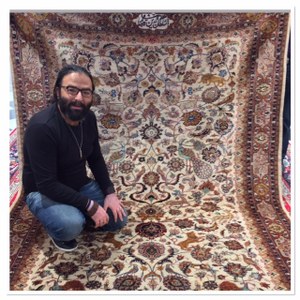What the majority of us don't know, however, is that long before this there was another carpet weaving center in Tehran. For that story, I need to take you back in time to Nasser din Shah of the Qajar Dynasty and the political and cultural turmoil that raged during his time. Amir Kabir was the prime minister at the time and his goal was to modernize Iran, especially the education system. Although Amir Kabir's efforts resulted in the first modern college in Iran, Dar Al Fonoon ("house of all knowledge"), all of the reforms ceased upon his death. Another gentlemen, Mr MIrza Hasan Roshdieh from Tabriz whose father was a religious scholar, was sent to Lebanon and Egypt by his father to learn about modern educational systems from them, but upon his return to Iran he realized that his country was not yet ready for these new educational concepts and so he opened his first school in Georgia. When Nasser din Shah came back from his trip to the West, he asked Mr Roshdieh to open similar schools in Iran, which he did in Tabriz and later Tehran. The king changed his mind, however, as he thought that these kind of schools will pour more oil on the fire for pushes towards constitutional revolution. After the king was assassinated, his son Mozafar din Shah inherited the thrown. He had an entirely different view towards educational and constitutional reforms than his father and many new school were established during his reign that were called Mozafarieh schools since the government helped fund it.
One of these new schools funded and managed by Mr Mirza Sayyad Mohammad Tabatabaei, one of the leaders of the Iranian constitutional revolution, was called Islam school and opened in 1899 in the Sangelaj district in the South of Tehran. Besides the modern educational curriculum he also brought the art of carpet weaving into the school with master weavers from Kerman as teachers of this craft. In two years time the carpets of this school became so famous that they found their way to the royal court and was also given as gifts to the Ottoman Empire by Mozafar din Shah. Sadly, after the death of this Shah, not only did the constitutional revolution meet its end, but the carpet weaving at this new school did too.
There is a pair of carpets signed "Madrese Islam" (Islam school) dated 1319 (circa 1901) dedicated to the kIng, woven with A-symmetrical knot, that was moved from the Golestan palace to the Carpet Museum of Iran in Tehran. At Ghorbany Carpets we have an exact replica woven by Ostad Akbari with a slight difference at the bottom of the carpet and it was woven either at this school or later. In any case this majestic carpet reveals and holds a piece of history that might have been forgotten otherwise.



